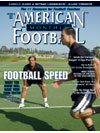AMERICAN FOOTBALL MONTHLY THE #1 RESOURCE FOR FOOTBALL COACHES
Article CategoriesAFM Magazine
|
The Strength Report: Developing the Explosive Athlete - Offensive Linemenby: Aaron HillmanHead Strength & Conditioning Coach, Bowling Green State University © More from this issue Training a football player is a year long endeavor. We have four years to develop the players under our charge. At BGSU we receive tremendous support from Head Coach Gregg Brandon and his staff in emphasizing the program to the players and allotting time for training during the NCAA imposed hour guidelines. The football staff also does a great job in identifying talent. When developing an explosive football player step one is evaluation. Players play certain positions because of body type, skill level and natural ability. Coaches must then train the player to maximize this potential. We refer to this as minimizing the ‘but, as in, he is a good player but…’ (he needs: strength, conditioning, weight gain, weight loss, etc.). This process will not happen quickly and the needs of each player are different each training period. Th....The full article can only be seen by subscribers. Subscribe today!
|
|
|||||||
| HOME |
MAGAZINE |
SUBSCRIBE | ONLINE COLUMNISTS | COACHING VIDEOS |
Copyright 2025, AmericanFootballMonthly.com
All Rights Reserved





